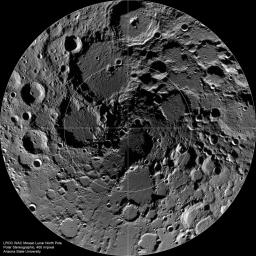
|
The Lunar North Pole
- Click the image above for a larger view
- Full-Res JPEG (1521 x 1521) (528.4 kB)
- Full-Res TIFF (1521 x 1521) (2.3 MB)
Caption:
Summer-time at the lunar north pole captured by the LROC Wide Angle Camera (WAC), width ~600 km, latitude ranges from 80°N to 90°N.
The lunar poles have long been places of mystery and promise. Since the Moon's spin axis is tilted less than 2 degrees relative to its orbital plane, the interiors of many topographic lows (mostly impact craters) never receive any direct sunlight. These regions are perpetually dark and thus very, very cold.
Background Info:
NASA's Goddard Space Flight Center built and manages the mission for the Exploration Systems Mission Directorate at NASA Headquarters in Washington. The Lunar Reconnaissance Orbiter Camera was designed to acquire data for landing site certification and to conduct polar illumination studies and global mapping. Operated by Arizona State University, LROC consists of a pair of narrow-angle cameras (NAC) and a single wide-angle camera (WAC). The mission is expected to return over 70 terabytes of image data.
Cataloging Keywords:
| Name | Value | Additional Values |
|---|---|---|
| Target | Moon | |
| System | Earth | |
| Target Type | Satellite | |
| Mission | Lunar Reconnaissance Orbiter (LRO) | |
| Instrument Host | Lunar Reconnaissance Orbiter | |
| Host Type | Orbiter | |
| Instrument | Lunar Reconnaissance Orbiter Camera (WAC) | |
| Detector | Narrow Angle Camera (NAC), Wide Angle Camera (WAC) | |
| Extra Keywords | Crater, Grayscale, Impact, Rotation | |
| Acquisition Date | ||
| Release Date | 2010-10-05 | |
| Date in Caption | ||
| Image Credit | NASA/GSFC/Arizona State University | |
| Source | photojournal.jpl.nasa.gov/catalog/PIA13528 | |
| Identifier | PIA13528 | |
